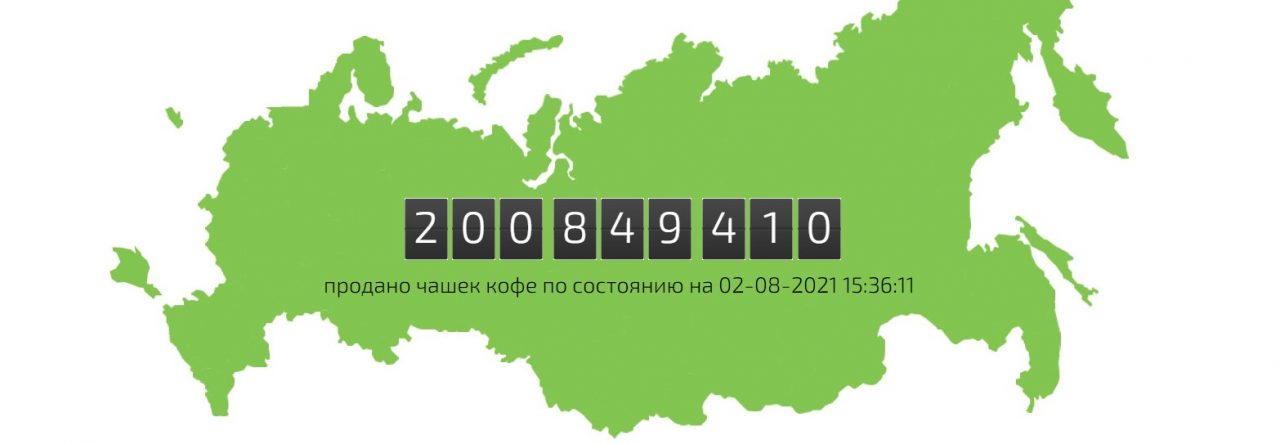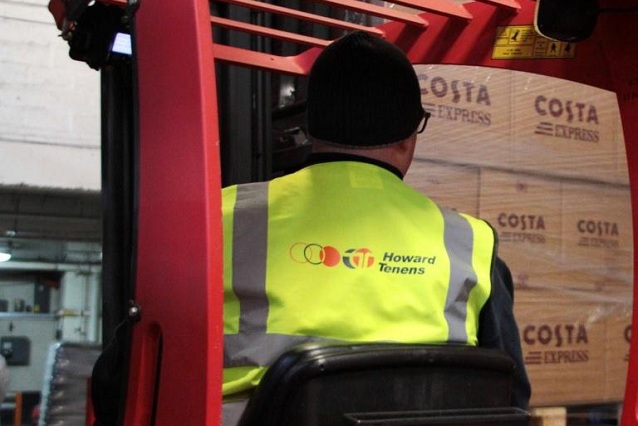When traditional logistic models and the organization of the supply chain have jeopardized the dynamic growth of the company, the owners of Costa Coffee went all-in. The company completely changed the leadership, adopted a new strategy for the organization of supply, hired a new logistics operator, and also introduced a new enterprise software to provide a new level of benefit from the telemetry component of its system. We believe that the final result speaks for itself.
Author’s note
When I was preparing this article, i was surprised by how similar problems had to be solved in RusHOLTS around the same time. An illustration of the similarity could be invention of the rad by Marconi and Popov. The problem is in the air and solution comes to those who are looking for it. Only RusHOLTS had to be tis own “new” logistics operator because of the lack of worthy proposals. No “regional partners”, no services outsourcing – only our own trained and well-managed structures that guarantee the high quality of work.
Developed by RusHOLTS experts ADR system, smart monitoring of coffee machines and analytics on customer request, a customer service of our own and the creation of the Monitoring Centre – are the details that make up the effectiveness of the coffee business.
Given Russian distances, poor road quality and penetration of the Internet in the regions, our experience of conquering Russian realities by telemetry is no less rich and interesting. And as you can see, quite in the style of the world’s leading coffee industry players!
Moving at a high-speed and operating 24 hours a day, the world has become dependent on coffee to maintain this pace of work. Do we run into the coffee shop or brew a cup of invigorating drink on our own in the office, staying overtime in the university library or in the hospital cafe, on the road or on vacation, we always look forward to the same level of quality of the drink, the familiar taste and adequate cost.
Costa Express brand was created by one of the largest operators in the HoReCa and owner of Costa Coffee – Whitbread Group in 2011, in order to promote self-service coffee, both as the company’s growth platform for the future work in general and as a the whole coffee industry in particular. We’ve already written about this in more detail.
The good performance of the first year of operation confirmed the reality of the ambitious plans of Costa Express to increase the number of machines at least to 3000 to the end of 2016.
Life without a supply chain manager
In the first months after the launch in 2011, the company’s business was in many respects like a blown horse. The existing fleet of coffee machines was transferred from under the Coffee Nation brand under the brand of Costa Express and some new partners have joined their servicing. The company worked to the point of exhaustion and under tremendous pressure to quickly get impressive dynamics of growth and justify the investment * of Whitbread. (* Approx. volume of project investment amounted to ? 60 million).
By April 2012, the company realized that in order to achieve the planned growth it will have to make some changes in the organization of the supply chain. At the time of making this decision, the company did not even have the position of supply chain manager. Traditional for the industry logistics and purchasing operations were distributed among employees of the financial unit and the engineering department.
At the first stage the staff of the company’s new business unit identified three fundamental functions of the supply chain, on which the business Costa Coffee should be based.
1. Management of ingredients replenishment for coffee making at the sales point
2. Providing sales points with spare parts for coffee machines.
3. Effective management of the delivery process of new Costa Express machines and their preparation for installation on the sales points.
The most critical for the entire business proved to be the first point, which will be discussed further.
Creating a logistics model
Successful solutions for existing sales model was the creation of the Brand Guardians institute. These employees work “in the field”, outside the office, to train partners, monitor inventory and provide consulting services in regard to the problems of increasing the sales and the quality of the final product.
The disadvantage of this Costa Express supply model was the supplying of all the necessary ingredients to sales points for franchise partners for free with the further division of the resulting revenues. These processes were implemented by the Department of Finance with the support of Brand Guardians.
In order to maintain such a work model in the period of intensive growth, Costa Express needed to ensure tighter control and visibility throughout the supply chain. The basis for this process became the clear understanding of exactly how much inventory of a particular ingredient each partner will need to avoid unnecessary costs of stock control both in time and in human resources, which, in the end, translates into the money.
That is, it was required to provide not only the collection of general information on the volume of orders, but also to obtain the most accurate data on the volume and frequency of deliveries to each individual sales point.
Solution of this problem can be provided by a modern telemetry system. All Costa Express machines were equipped with modules that provide collection and sending of work-related data of each machine in real time. This upgrade had a double purpose: to prevent theft and losses, as well as improving service quality through continuous monitoring of ingredients inventory on each machine.
The system, on which previously relied the entire mechanism of decision-making on the supply of ingredients to the Costa Coffee sales points, was composed of thousands of related dynamic spreadsheets containing detailed information about each point and each pruduct unit. In view of the chain volumes, the system processed more than 50,000 replenishment parameters and grown to 100,000 along with the chain’s growth.
Despite the investment in coffee machines with built-in programs for the processing of sales data online, Costa Express could not draw the maximum benefits from this volume. Dynamic spreadsheets did not allow to retrieve, consolidate and output data according to the set parameters as of the time of the request. (Author’s note. Big data and smart analytics go hand in hand, one without the other being useless. Confirmed by many episodes in working practice).
In addition, current company’s logistics partner was involved according to a full range of services model: it ensured the purchase of all of the ingredients through direct transactions with suppliers, invoiced them for the purchase and delivery to the designated points of sales. Despite the fact that such a scheme has been effective at the beginning of its application for the company, for Costa Coffee it meant an almost complete lack of direct interaction with the suppliers of ingredients, which complicated the process of negotiations with them as the business grew. ( Author’s note. How many managers of filling stations were tortured by the question: To create a coffee business of their own, or to outsource it? Outsourcing always means that you don’t have your own coffee business. You have to understand the limits within which such a situation will suit you).
It became clear that to ensure stable growth of the company it will need to transform both components and redistribute roles within the company, and it had to do it very quickly!
Defining priorities
The initial changes began with laying the foundation for the entire block of strategic changes – the transfer of responsibility for the replenishment of the partner network from the finance department to the new team created specifically to monitor this component of the company’s work.
Inventory replenishment from a by-side activity was turned to an independent area of responsibility with the proper amount of attention. Further on the revision of the software providers list was conducted. The main task – the effective use of telemetry data for inventory on partner’s sales points.
In June 2012 a competition was held to find a new logistics partner. The process also included a review of relations with suppliers and an assessment of whether the company had to move to a model of direct purchases from suppliers of ingredients.
By November of 2012 a new planning tool of restocking partners’ sales points was created. Also, was found a new provider of logistical services, the company Howard Tenens, which was supposed to start in January 2013.
Howard Tenens collected ingredients from suppliers – coffee, syrups, cups, lids, napkins and so on and delivered all of this to the central warehouse from which further redistribution to Costa Express partners was undertaken on as-needed basis.
Apart from the fact that this model allowed for direct purchases, a new partner was able to greatly simplify the entire logistics component of the work as a whole. Previously, in addition to the central warehouse there were 9 regional ones. As of now everything’s tied to a single main site, which allowed immediately to increase the number of deliveries performed by the model of “next day after the order”.
Besides this Howard Tenens provided logistical support of services tasks as to the coffee machines (spare parts and so on). (Author’s note. Partial functions of services provider. It is good that the logistics company ensures the delivery of spare parts, replacement machines, etc. But telemetry gives excellent results as to the preventive maintenance of coffee machines. There is such a paradox – repairing before the machine actually breaks down. This is a huge part of the savings on coffee machines service, it is worthy of a dedicated article).
Another advantage of Howard Tenens was the fact that most of its transport company holds a combined diesel and gasoline fleet, or runs vehicles completely on biometan fuel. This means savings of about 73 metric tons of carbon dioxide emissions per year. (Author’s note. For Russia, the world’s biggest nartural gas provider in the world, it’s rather an unexpected option for selecting a logistics partner. I would like to live to see such times here).
The main parameters of the new logistics model
By January 2013 were implemented three major changes in the supply chain – new IT system, new logistics operator and a new procurement model.
New IT component of the company consisted of the introduction of the ToolsGroup product – SO99 +, which controls all the processes of supply planning, forecasting growth, as well as inventory. Software has significantly improved the quality of forecasts at the same time managed to maintain the high quality of customer service by reducing the number of delivery episodes.
Prior to this, Costa Express system had to use the spreadsheets to determine how much and what exactly was required to be delivered to a sales point, using calculations based on current reserves, as reflected in the system, as well as on the record of average level of sales of cups per point.
The new system allows you to compare sales data with inventory levels at all sales points, which improves the transparency of the operations and the level of accountability.
The system is based on data that is updated every 4 minutes and collected from 3000 machines to determine current trends and predict future demand. The high frequency of updates on all key indicators allows to calculate the precise changes in demand scenarios to determine how much of the goods to be delivered to a specific sales point. The system creates the schedule of deliveries to ensure a perfect balance between maximizing availability without creating overstock. All of this happens automatically and on the basis of cloud technologies.
The system allowed to reconsider the role of “Brand guardians”. The new software has become much faster, more accurate and easier to use as compared to the system of spreadsheets. «Guardians» got time and opportunity to focus their efforts on customer service (maintenance, troubleshooting, development promotion programs, etc).
After first 6 months of working with the new IT system and logistics operator, as well as under the new scheme of the alignment of all components yielded the following results – 20% reduction in the level of stored goods at partners’ sales point, 50% reduction in the number of failures in the acceptance on the part of partners, direct purchases model was established with 15 suppliers providing 50+ of all SKU.
Increased sales volumes led to the possibility of reducing the purchase prices in some areas. By 30% reduced the annual cost of business logistics services and the annual reduction in CO2 emissions amounted to 70 metric tons.
Before changing patterns of work, each sales point kept on average more than 20 boxes of various goods. After innovations, this figure fell to 12 boxes, a box by SKU. (Although there are 50 SKU in the range, usually a sales pount requires not more than 15 of them).
In short, partners are completely cleared of all warehouse management tasks and the level of confidence in the uninterrupted and timely delivery that will not lead to a downtime or overstock allows to get a better focus on solving current business problems.
A popular metric to assess the level of customer loyalty, Net Promoter Score, grew in the first six months by 10%. The general level of satisfaction with the service and the number of continuing purchases rose by 5%, the level of recommendation to friends and acquaintances – 6%.
Without this “revolution” to support the planned business growth would be impossible – it laid the foundation for growth both in the UK and internationally. As we have seen, the basis of Costa Express system is the most powerful telemetry, that allows to receive the maximum fresh data on the operation of each device and adjust the ingredients streams, spare parts and logistics services strictly in the case of the arising need, which allows to increase the efficiency of business management to a whole new level.



Leave a Reply